I . Survey
(i) Location
Jiangsu province, as short as Su, is located in the middle of the east coast of China between Longitude East 116 ° 18 ' and 121 ° 57 ' , Latitude North 30 ° 46 ' and 35 ° 07' . It lies within the lower reaches of the Yangtze River and the Huai River, and is adjacent to the Yellow Sea on the east, to the Anhui province on the west, to the Shandong province on the north, and to the Zhejiang province and the Shanghai city on the south. It covers an area of 102.6 thousand square km, about 1.06% of the total area of China, ranking the 24th. The province has a fl at terrain, which has vast plains without big mountains.
Jiangsu has numerous lakes and a dense network of waterways. With some hills in the northern part and the southwestern part, Jiangsu has a large area of plain mainly consisting Jianghuai (the Yangtze River and Huai River) Plain, Huanghuai (the Yellow River and Huai River) Plain, Eastern Seashore Plain, and Yangtze Delta from north to south. The plain area of Jiangsu is 70.6 thousand square km, about 68.9% of the total area of Jiangsu; the water surface area is 17.3 thousand square km, about 16.8%; the hill area is 14.7 square km, about 14.3%. Located in the suburb of Lianyungang, the Yunnv apex, Yuntai Mountain, is 625 meters above the sea level, the top one in Jiangsu. It has large percent of plain area and water area, and less percent of hill area, which all ranking the fi rst in China and giving Jiangsu the reputation of “ Region of Rivers and Lakes ” . Main Cities
There are 13 municipalities under the jurisdiction of the provincial government, n a m e l y , N a n j i n g , W u x i , X u z h o u , Changzhou, Suzhou, Nantong, Lianyungang, Huai ' an, Yancheng, Yangzhou, Zhenjiang, T a i z h o u , a n d S u q i a n . U n d e r t h e s e municipalities, there are 106 counties or county-level cities, including 27 country level cities, 25 counties, and 54 districts. The capital of the province is Nanjing.
(ii) Climate
Situated in a transition belt from a subtropical to temperate zone, Jiangsu has a mild climate, with a cold winter, a hot summer and distinguished seasons. January is the coldest month of the year, and July is the hottest one. The average temperature of Jiangsu Province descends from north to south, which is about 13 ℃
-16 ℃ . Affected by the East-Asian Monsoon, it has more rainfall in the summer than in the winter. The average rainfall is about 1,000 mm.
(iii) Population & Nationalities
Jiangsu has a population of 74.745million, in which 3,746 million are residents of cities or towns. There are 55 minority nationalities in Jiangsu, with a population of 260 thousand, about 0.36% of the total population of the province. And 51% of the people of minority are Hui Nationality.
(iv) Infrastructure and Transportation
Facilities
Jiangsu has a colligated transportation network, including railway, highway, waterway, airline, and duct transportation, connecting in and out the province. The mail and telegram of the province are developed, which has constructed the network of electricity, microwave, shortwave, satellites, mobile phones, and digital telegram.
Airport
7 cities in Jiangsu have airports. Domestic airlines can connect all big and middle cities in the country. The international airlines can go to America, west Europe, and Africa. Nanjing Lukou International Airport is the main civil airport in China, and the main cargo airport in the East China, which has 85 airlines in or out of the country and can land and take off all big airplanes of all models.
Now, it has the passenger airlines connecting with Hong Kong, Macao, also Taibei and Gaoxiong transferred at by Macao, Kuala Lumpur, Bangkok, Nagoya and Seoul; the cargo airlines connecting with Winnipeg, and Moscow.
In 2005, Nanjing Lukou International Airport handled 5.1 million passengers, 165 thousand tons of cargo, having fulfilled 55,000 stories air transportation.
Railway
The railway network in Jiangsu can connect with more than 40 big and middle cities in the country. There are two railway hinges, namely, Nanjing and Xuzhou, and three railways, namely, the railway from Beijing to Shanghai, the one from Nanjing to Wuhu, and the one from Lianyungang to Urumchi. Since 1992, starting from Lianyungang on the east and ending by Rotterdam on the west, the New Asia-Euro Continental Bridge, which is a convenient and economic transport channel of Asia- Europe joint sea-and-rail transportation with a length of 10,900 km, takes more than 95% international railway transportation. Moreover, Lian Yungang is given the name of “ East Bridgehead ” of New Asia-Euro Continental Bridge.
Highway
Centered in Nanjing, Jiangsu has constructed a dense highway network to all cities, counties and towns. The main highways are expressway, the first level highway, and the second level highway in the province and some high level way connecting with other provinces. By the end of 2005, the total provincial expressway reaches 2,886 km, ranking the third in the length of China.
Harbor
Jiangsu has 11 opened up harbor of class I, such as the Lianyungang Harbor, the Nanjing Harbor, the Nantong Harbor, and etc, and 128 berths of 10-thousandton level, which can be opened for the foreigners, with the throughput of the import and export volume of about 114 million tons. The Lianyungang Harbor is one of 8 biggest harbors in the country, and the most economic and convenient harbor for the middle and northwest china. The Nanjing harbor is the biggest freshwater harbor in Asia with the throughput of more than 100 million ton, which connects with 160 harbors in 76 countries and regions.
Shipping
Jiangsu ' s freshwater shipping has a special geographic advantage. For about 400 km route, a part of the Yangtze River, across the province from west to east; and about 690 km route, a part of the Great Canal, across the province from north to south. It has 24,793 km fresh water route in the province, about 18.4% of the total of the country. It has 7,546 km route above level 7 and 1,781 km route above level 4, taking up 7.2% of the total of the province, and 11.8% of the total one above the level 4 of the country. Both the number and the length of the route are the fi rst in the country. The middle and lower reaches of the Yangtze River across the province, and the Yangtze River bridges are the main channels for connecting the north and the south. The Yangtze River bridges in the province have their own characters.
The Nanjing Yangtze River Bridge is the combined highway and railway bridge, which is designed and constructed by ourselves; the Jiangyin Yangtze River Bridge is the first in the country and the fourth in the world of the span in the kind of the suspension bridge; the No.2 Nanjing Yangtze River Bridge, which is 21.197 km long, and its main span is 628 meter, is the first one in the similar bridge in the country and the third one in the world; the Runyang Yangtze River Bridge, which is 35.66 km long, is the first grand bridge combined by the cable stayed bridge and the suspension bridge.
Finance
In 2005, Jiangsu has 9,662 finance units, such as state-owned bank, policy-related bank, other business bank, urban business bank, rural business bank, urban credit cooperative, rural credit cooperative, and etc.
Insurance
There are 29 insurance companies, 4,033 branches, and 150 thousand staff in the field of insurance in Jiangsu now.
The insurance income of the province was 43.734 billion yuan in 2005, about 8.9% of the total one of the country. The property insurance income was 9.75 billion yuan, and life insurance income was 33.984 billion yuan.
Post and Telecommunication
Jiangsu has built the long-distance transfer network, which is made by the optical cable as the main one and the digital microwave as the supplement, and realized the programmed controlled exchanging and transferring by the digital of the village level. The mobile phone signal has covered the whole province, and the mobile phone can be cruised all over the country.
The operation of the digital telecom and them multimedia telecom appears continually. The integrated telecom ability of the province is the second of the country. Advanced information and technology networks, such as the public information network, the intelligent network, the optical cable network, digital updated network, information administration network, and etc, have been used widely in Jiangsu. In 2005, there were 56.133million telephone subscribers in Jiangsu with 30.591million fixed-line ones and 25.542million mobile ones, reaching a popularizing rate of 75.6 per hundred people. There were 1.58 million internet dial-up subscribers and 2.908 million broadband ones.

(v) Foreign Exchanges
International Sister Provinces and States, and Sister Cities Jiangsu has developed the foreign exchanges for many years, and had built the friendship with dozens of the countries in all fields, levels, and forms. By the end of 2005, Jiangsu province has 166 pairs of sister city, 23 pairs of sister province or state, which promote the exchanges with the foreign countries in all fields, such as economy, science and technology, culture, education, public health ,sport, tourism, environmental protection, and etc, increasing the understanding and friendship between each other, and putting forward the common development and progress.
International Sister Provinces or States of Jiangsu.
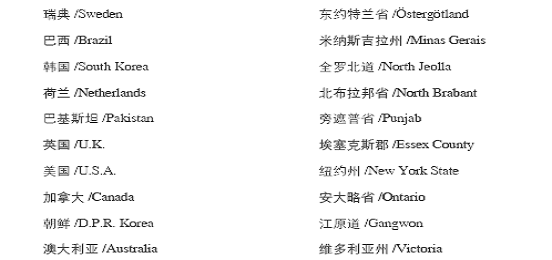
Foreign Expo
There are numerous international business activities in Jiangsu, such as, Nanjing Golden Autumn Economic and Trade Fair and Suzhou Electronic Information Expo, J i a n g s u E x p o r t P r o d u c t s Expo (Japan), Jiangsu Export Products Expo (Sri Lanka), Jiangsu Export Products Expo (Tanzania), Jiangsu Export Products Expo (Nigeria), and etc.
China Nanjing Golden Autumn Economic and Trade Fair: it is held from the end of September to the beginning of October each year in Nanjing, which has become a well-designed brand by Jiangsu to attract investments since the 1st fair held in 1990.
Suzhou Electronic Information Expo: it is held in October each year in Suzhou, the largest-scale IT Expo.
(vi) Higher Education and Scientific Research
In 2005, Jiangsu houses 115 colleges and universities including well-known universities in the top rank of China, namely Nanjing University, Southeast University, Nanjing Normal University and Nanjing University of Aeronautics and Astronautics.There are 1.2377 million registered students,120,440 faculties, and 67,334 teachers;150 technical secondary schools, with661 thousand registered students, 20,987faculties, and 14,240 teachers.
In 2005, there are 3,584 scientific research and technological development institutions in Jiangsu with 355,000 workers engaged in scientific activities, among which 100,500 are research and development workers, and 94 academicians of Chinese Academy of Science and Chinese Academy of Engineering. Jiangsu Province has established 166 state or provincial level high-tech research key laboratories, engineering research centers and public sic-tech service platforms.
In 2005, 32achievements in Jiangsu received National Science and Technology Awards, 34,811Patent Applications were raised with 13,580approved.
(vii) Tourism
Scenic Spots and Historical Sites
Jiangsu , with its hills, lakes, springs, gardens, and temples, has been an ideal destination for tourists since ancient times, with 16 citiesbeen awarded with the title of China Excellent Tourism City. The scenery of Taihu Lake is the most beautiful one in five big freshwater lakes. Other lakes, such as Xuanwu Lake and Mochou Lake in Nanjing, Shouxihu Lakein Yangzhou, Yangcheng Lake in Suzhou, Yunlong Lake in Xuzhou, Tianmu Lake in Liyang, have their own characters.
There are some scenic spots with the title of China's AAAA level Tourists Attractions, such as Confucius Temple in Nanjing, Huqiu in Suzhou, Yuantouzhu in Wuxi, Tianning Temple in Changzhou, Red-crowned Crane Nature Reserve Park in Yancheng, and etc. Jiangsu is famous for its traditional gardens, as Humble Administrator's Garden and Lingering Garden in Suzhou are of the four most famous gardens in China. Nine traditional gardens in Suzhou, which named as ‘ heaven in the world ' , have been inscribed by UNESCO on the World Heritage List. In July 2003, Nanjing Mingxiaoling Mausoleum has been inscribed on the World Heritage List, too.
And there are some famous temples, such as Xixia Temple in Nanjing, Jinshan Temple in Zhenjiang, Daming Temple in Yangzhou, Hanshan Temple in Suzhou, Longchang
Temple in Jurong, and etc. Zhongshanling Zhongshan ling is the mausoleum of Dr. Sun Yat-sen,great forerunner of China's democratic revolution. It is situated on the southern slope of Xiaomaoshan, eastern hill of Purple Mountain in eastern suburbs of Nanjing, Jiangsu, adjoining Xiaoling Tomb of the Ming Dynasty in the west and Linggu Temple in the east. The whole architectural complex ascends by the mountain, full of power and magnified cense. The mausoleum is shaped like an alarm bell with the meaning of “ awakening the nation to found a Republic of China ” .
Xiaoling Tomb of Ming Dynasty
Xiaoling Tomb of Ming Dynasty is the tomb of the first Emperor of Ming Dynasty, Zhu Yuanzhang and his queen. It is located at the foot of Wanzhu Hill of Dulongfu of southern Purple Mountain, adjoining Zhongshanling in the east and Plum Blossom Hill in thesouth. It is the biggest emperor ' s tomb in Nanjing and one of the biggest in China.
In July 2003 Xiaoling Tomb of Ming Dynasty was formally added to World Heritage List on the 27th World Heritage Conference.
Suzhou Gardens there are over 10 well-known gardens in Suzhou, namely Canglang Pavilion, Lion Forest Garden, Humble Administrator ' s Garden, Lingering Garden, Master-of-Nets Garden, Joyous Garden, etc. The coverage of Suzhou Gardens is small. However, within the limited area, Suzhou Gardens integrate spice of Chinese traditional paintings into artistic conception of Tang Poetry and Song Ci, which are interspersed with rockeries, trees, pavilions and vlies so that an artistic effect of multum in parvo is attained.
Special Arts and Goods
The traditional arts in Jiangsu are various and excellent skilled. Nanjing Yun Brocade and Suzhou Song Brocade are the two of three famous brocades in China. Wuxi Huishan Pottery Figure is the treasure of the colorful sculpture in China, and its masterpiece is the Daafu.
There are also some other arts brighten Jiangsu traditional culture, suchas Yixing Chinaware, Huqiu Pottery Figure, Nantong Kite, Yangzhou Jade Scuplture and Lacquer, Changzhou Comb, Suzhou Embroidery and Taohuawu Wooden Sculpture Picture Special for the Spring Festival, and etc. Nanjing Yuhua Stone, Donghai Crystal, and Taihu Lake Pearl are valuable and good for collection.
Special Foods
Jiangsu has various special foods. The history of the Nanjing Ban Duke is more than 500 years; the Zhenjiang Vinegar has a deep color and a sweet-smelling taste; the Biluochun Tea is one of ten famous teas in the country, and the best of green tea; the Yancheng Lake Crab is the king of the freshwater crab; the Lianyungang Dongfang Prawn has lots of nutriment.
Jiangsu has some famous special foods, such as the Taixing Huangqiao Pancake, the Xuyi Lobster, the Peixian Dog ' s Meat, the Dongtai Noodle with Fish Soup, the Kunshan Aozao Noodle, the Yangzhou Fuchun Steamed Dumpling, the Su-style Rice Candy, the snacks in Confucius Temple nearby the Qinhuai River, and etc.
II . Economy
(i) GDP
In year 2005, the provincial GDP in Jiangsu reached 1.8 trillion RMB, and per capita GDP came up to 24.515 RMB, or about $3,038.
(ii)Major resources
Mineral resources
By the end of 2005, 133 kinds of mineral resources have been found in Jiangsu Province, including 4 kinds of energy mineral resources, 19 kinds of metal mineral resources and 39 kinds o f n o n m e t a l mineral resources . T h e total potential value of the solid mineral resources in Jiangsu will reach 917.4 trillion yuan. The reserve quantity of coal mine, salt mine, iron mine and phosphorite ranks on the top of the list.
Aquiculture Resources
Neighboring the Yellow Sea in the east, and boasting a costal line extending 1,040 kilometers and extensive network of rivers and lakes, Jiangsu enjoys strong advantages in developing aquiculture. There are over 140 kinds of fresh water fishes, mainly carp and rice field eel, and over 150 kinds of sea fishes, mainly butterfish and ribbon fish. Besides, there is also a large quantity of shrimp and crab. Water plant is another important recourse in the province, like reed, lotus, water caltrop, etc.
Water Conservancy and Power Supply
Jiangsu is located within the reaches of the Yangtze River, the Huaihe River and Yishu River. Now, we have established a comprehensive water conservancy system combining the efforts of flood prevention, drought prevention and tide prevention.
The total power consumption in year 2005 was 219.3 billion kilowatt-hours, and the installed units capacity of the power system was 42.7 million kilowatts.
Animal and Plant Resources
There are about 850 kinds of plants, and over 600 wild plants. There is a small quantity of wild animals, most of which are birds, like wild chicken and wild duck. The protected precious poultry, like red-crown crane, white crane and swan can be found in some coastal areas.
(iii)Important Data in Agriculture and Industry
Agriculture
In 2005, the crop planting covers a total area of 4,909.5 kilo-hectares with total crop output of 28.3 million ton. Cotton and oil bearing plants cover an area of 368.3 kilo-hectares and 846.9 kilohectares respectively, and vegetable planting covers 1,194.4 hectares. The total output of industry, building, transportation, whole sale and retail, trade and catering in rural areas accounted for over 90 percent of rural GDP.
Industry
The value-added of industry in 2005 was 932.6 billion yuan. State-owned sector, collective sector, private sector, share holding sector and foreign-invested sector all achieved sound development.
(iv) Bussiness
Foreign Trade
Foreign Trade has increased steadily. In 2005 the total customs export-import volume in Jiangsu Province added up to 22,795.5 billion dollars with 122,299.4 billion dollars imports and 10,496.2 billion dollars exports.
Exports consisted of 4,063.3 billion dollars general trade, 8,205.1 billion improvements trade and 8,402.3 billion dollars mechanical and electric products. While exports consisted of 2,567.2 billion dollars general trade, 6,487.4 billion dollars improvements trade and 7,247.5 billion dollars mechanical and electric products.
Foreign Investment
Foreign investment increased steadily in Jiangsu. In 2005, Jiangsu Province approved 5,108 foreign investment projects in total , the actual foreign capital reached 13.18 billion dollars. The total amount of foreign capital of Jiangsu reached 103 billion dollars by the end of 2005.
International Economic Cooperation
In 2005, with the total contract price of 3.31 billion dollars, Jiangsu Province actually gained 3.197 billion dollars by overseas projects and labor cooperation. 44,163 people were sent abroad in 2005, and 100,280 people were sent abroad in total. Many large and medium-sized enterprises of Jiangsu took over large construction objects in other countries, which could enhance enterprises' competitive strength.
Overseas Investment
In 2005, Jiangsu Province approved 163 overseas investment items. Chinese investment reached 205.04 billion dollars.
Internal Trade
In 2005, total retail sales of consumer goods of Jiangsu Province reached 569.989 billion yuan. In terms of the different industries, the total sales of wholesale and retail trade reached 501.609 billion yuan, the total sales of catering industry reached 58.309 billion yuan. There were 4,934 goods trade markets in Jiangsu, and 452 of them broke through the transation value of 100 million yuan. The total sales reached 480.846 billion yuan.
2005 年江苏省进出口情况
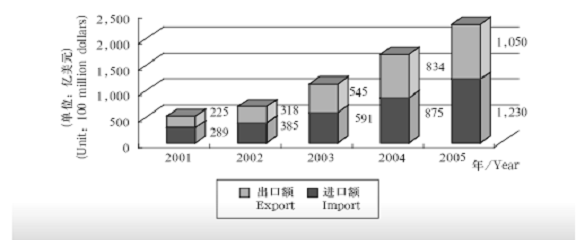
2005 年江苏进出口主要国别、地区情况
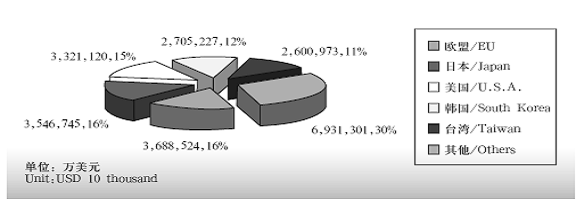
2005 年江苏省实际利用外资情况
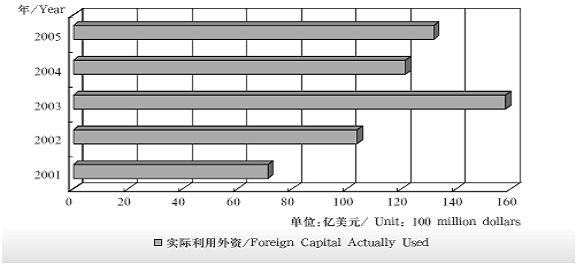
2001-2005 年江苏外资企业经营额占江苏比重
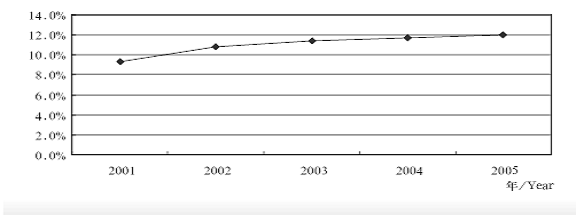
2001-2005 年江苏省境外投资情况
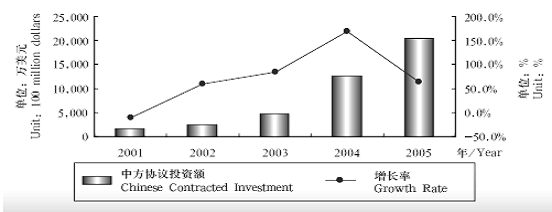
江苏省社会消费品零售总额

Composition of Total Retail Sales of Consumer Goods in Jiangsu Province
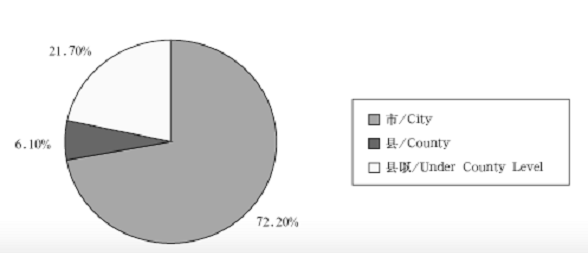
III . Investment
(i)Policy and Administrative Rules
Catalogue of Related Laws
Foreign Trade Law of the People ' s Republic of China
Customs Law of the People ' s Republic of China
Law of the People ' s Republic of China
on Import and Export Commodity Inspection
Law of the People ' s Republic of China on Chinese-Foreign Equity Joint Ventures
Law of the People ' s Republic of China on Chinese-Foreign Contractual Joint Ventures
Law of the People ' s Republic of China on Foreign-Capital Enterprises
Company Law of the People ' s Republic of China
Law of the People ' s Republic of China on the Entry and Exit Animal and Plant Quarantine
Law of the People ' s Republic of China on Control of the Entry and Exit of Aliens
Law of the People ' s Republic of China on the Control of the Exit and Entry of Citizens
Securities Law of the People ' s Republic of China
Income Tax Law of the People ' s Republic of China for Enterprises with Foreign Investment and Foreign Enterprises
Individual Income Tax Law of the People ' s Republic of China
Law of the People ' s Republic of China on the Administration of Tax Collection Environmental Protection Law of the People ' s Republic of China
Law of the People ' s Republic of China on Evaluation of Environmental Effects
Law of the People ' s Republic of China on Promotion of Cleaner Production
Law of the People ' s Republic of China on Prevention and Control of Desertifi cation
Marine Environment Protection Law of the People ' s Republic of China
Law of the People ' s Republic of China on the Prevention and Control of Atmospheric Pollution
Law of the People ' s Republic of China on Prevention and Control of Environmental Pollution by Solid Waste
Law of the People ' s Republic of China on Prevention and Control of Water Pollution
Law of the People ' s Republic of China on Prevention and Control of Environmental Noise Pollution
Law of the People ' s Republic of China on Prevention and Control of Radioactive Pollution
Frontier Health and Quarantine Law of the People ' s Republic of China
Labour Law of the People ' s Republic of China
T r a d e U n i o n L a w o f t h e P e o p l e ' s Republic of China
Searching Website for the Related Laws
1 . S e a r c h i n g S y s t e m o f L a w s a n d
Regulations of China (website of National People ' s Congress of China)
http://law.npc.gov.cn:87/home/begin1.cbs
2. China Legislative Information Network System
http://www.chinalaw.gov.cn/jsp/jalor/index.jsp
3. Ministry of Commerce
http://www.mofcom.gov.cn
The above-mentioned websites are forreference only.
(ii)Jiangsu gives priority in developing the following industrial sectors in the future
1. Modern and high-effi cient agriculture
To develop high efficient, export oriented eco-agriculture, enhance general productive capability and competitiveness of agriculture so as to improve the income of farmers.
2. Equipping manufacturing
To promote the application of advanced design and manufacture, information technology and to speed up restructuring and technology upgrading mainly in the sectors of auto, shipping, engineering machinery, NC machinery tool, apparatus and other equipment with special usage.
3. Electronic information
T o c o n s o l i d a t e a n d i m p r o v e t h e electronic information industry, mainly i n t h e s e c t o r s o f I C , n e t w o r k a n d communication equipment, photoelectrical display, IT home appliances, electronic car products and new electronic parts and components.
4. Biology and medicine
To speed up the application of biotechnology, to focus on the development of new vaccine, genetic engineering and modern TCM, to promote large scale business operation of animal breeding and enzymic preparation production, and to develop bio-fuel.
5. Basic material and new material
To focus on the development of traditional basic materials like special metallurgy, petrochemical and new building material, to promote the development of new materials like chemical fiber, highmolecular material, nanometer material and also olefin and aromatic hydrocarbon products.
6. Modern textile
To improve technology and to foster brand production and to improve quality.
7. Modern service
To focus on the development of modern logistics, software, financing, business and technological service, and to speed up the development of information service, cultural industrial, tourism and real estate.
(iii) Procedures for Setting Up Enterprise
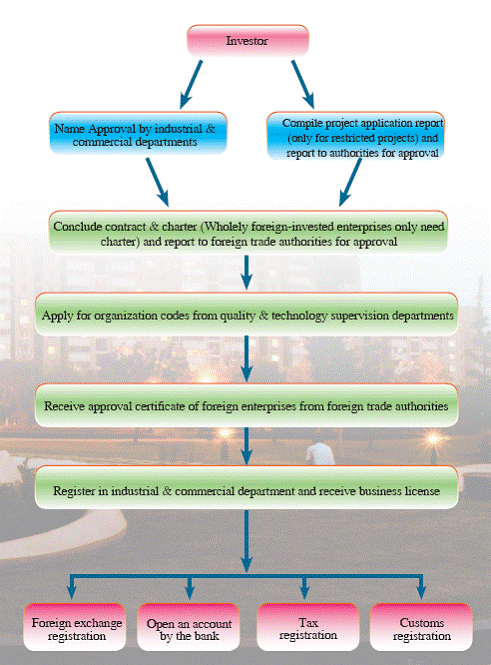
(iv) Submission Application documents shall be submitted by applicant
1. Foreign Enterprise
1 ) Preliminary Offi cial Check Paper
2 ) Application Form for Setting Up Foreign Business
3 ) Feasibility Study Report
4 ) Articles of Association for Foreign Business signed by authorized representative
5 ) List of Foreign Business Chairman of Board, Vice Chairman, and Board Members
6 ) Certifi cation of Investor ' s Identity (with Notary) and Credibility
7 ) Valid ID certifi cation for Members of the Board and authorization letter signed by legal representative
8 ) Required documents from Environmental, Firefighting, and Land Government authorities
9 ) Business Name Check and Approval Notice
10) Equipment List
11 ) Authorization Paper for legal documents delivery
12 ) Other documents that may requested by approval authority
2. Sino-Foreign Joint Venture, Sino-Foreign Cooperation
Local approval governing authority shall submit the following documents to Jiangsu Foreign Trade and Economic Bureau:
1 ) Preliminary Official Check Paper
2 ) Application Form for Setting Up Sino-foreign Business
3 ) Feasibility Study Report by both Sino-Foreign Parties
4 ) Business Agreement, Contract and Articles of Association signed by Sino foreign authorized legal representative
5 ) List of Foreign Business Chairman of Board, Vice Chairman, and Board Members from both Sino-foreign sides
6 ) Certification of Investors ' Identities (with Notary for foreign business) and Credibility
7 ) Valid ID certification for Members of the Board and authorization letter signed by legal representative
8 ) Required documentations from Environmental, Firefighting, and Land Government authorities
9 ) Business Name Check and Approval Notice
10 ) Previous year audited finance report for China Business party (check owner ' s equity)
11 ) Equipment List
12 ) Authorization Paper for Legal documentation delivery
13 ) Other documents that may requested by approval authority
Foreigner to Obtain Visa
Handling Authority : County and City Public Security Bureau and Entry-Exit Management Authority
For Information : Local (County, City) Public Security Bureau Entry-Exit
Management Authority Info. Line : 86-25-83526706 Jiangsu
Public Security Bureau Entry-Exit Management Authority
Documents required for visa application:
1. Valid international traveling document, including diplomatic, offi cial (offi cial, special personnel), public, private types of passports etc.
2. Fill out ‘ visa application form for foreigner ' , with one 2 ” sized passport use photo (Without hat).
3. Other documents related to visa application.
Foreigner working in Jiangsu Application Procedure : Employer submits application → City Level Labor Management Authority Checks → Provincial level Labor Management Authority Approves Documents required for “ Foreigner Employment Card ” Application:
1. “ Foreigner Employment Registration Form ” (Filled out by Employer, 3 copies, stamped by City Level Labor Management Authority) ;
2. “ Foreigner Employment Permission Certificate (Copy) ;
3. Labor Contact signed between Employer and individual foreigner original and copy (Legal representative from foreign invested business does not need) ;
4. Valid passport or equivalent other international traveling certificate (Original and copy) ;
5. Health certificate or equivalent issued by Jiangsu Entry-Exit Inspection and Quarantine Bureau(the Original one and a copy) ;
6. Residency Registration Proof from local Public Security Bureau (Copy) ;
7. Recent one 2 ” sized passport use photo.
Residency Registration
A c c o r d i n g t o C h i n e s e l a w , a n y fo reigner w ho inten ds to res id ent in China for over three months, shall make accommodation registration. Foreigner may apply from China ' s overseas Consulate an “ X ” visa for study purpose in China or a “ Z ” visa for work purpose in China, then apply for “ Residency Card (Certificate) ” from Jiangsu local Public Security Bureau Boarder Management Authority.
Normally the valid date of Residency Card is the same with visa, if foreigner wants to stay over the expiry date, he/she shall make a request for extension 3 days before expiration date. There is no need for more registration if foreign travels to other part of China.
Foreigners Invite relatives and friends to visit Foreigner who stays in China for a long period of time may invite relative or friend to come to China. Relative and friend shall take the invitation to China ' s overseas ' consulate for visiting visa application. The consulate usually will issue one month visiting visa, or maximum no longer than three months visiting visa. If short-term visiting visa holder can not leave China for special reasons when visa expires, he/she shall, via the consulate, to make request for visa extension to local public security bureau boarder management authority. Tourist visit can extend only once, with a period no more than 1 month. Visiting relative visa can be extended for maximum two times, with a period of 3 months for each time.
Drive on the Road
According to China ' s transport management regulation, foreigners need to obtain a “ Driving License of People ' s Republic of China ” in order to drive motor vehicle in China. For foreigner driver license holders, they may go to the local city public security bureau vehicle management office to make license transferring, by bringing valid foreign driving license and personal identification.
If there is no international driving license or no driving experience, they may go to any of the local driving school in Jiangsu to get trained. And they will be issued a driving license after they successfully accomplish the driving course, undertake physical check and pass the driving test. China is a high population density country and Jiangsu is the one of the highest place in China. Therefore, driving on road needs to be familiar with the road condition, traffic rules and signs. It is suggested that at the beginning stage, new drivers to be accompanied by experienced drivers, until they become more skilled.
When traffic accidents occur, you ought to stop the vehicle, protect scene, rescue the injured, and report to nearest police. When police investigating, you are obligated to show your ID, state fact, leave just after investigation fi nishing, and agreed by police.
If it cannot fi nish on spot, shall assists police to write down your ID, car plate number and ways of communication.
(v) Living Environment
About our cities
Jiangsu has a long history of metropolitan development. In the 19th century, China has 6 cities amongst the world top 10 cities whose population were over half million. Jiangsu has Jiangning (as today ' sNanjing), Yangzhou, and Suzhou. In recent years, Jiangsu has witnessed fundamental changes in both urban and rural areas. In year 2005, urban population income reached RMB12,319. Registered unemployment rate decreased continuously, with newly created employment of 3.8 million.
Increasing welfare coverage system namely retirement insurance, medical insurance, unemployment insurance reached 96.8%, 90.3% and 99.4% respectively.
Jiangsu has implemented sustainable development strategy, promoted ecological and environmental friendly development. Jiangsu has rich history and culture, peace and harmony social environment, convenient living facility, and business friendly policy in the many cities.
Education
Jiangsu respects education and had many famous intellects in history. Among the 212 top intellects in Ming and Qing Dynasties, Jiangsu had 66, or one third of the amount. Even more intellects appeared in the recent era.
Now, Jiangsu has 99.7% schooling rate for primary school, 89% for senior middle school, and 33.5% for higher education, which is 12% higher than national average. Jiangsu has 115 universities and institutes, with 1.230 million people enrolled in, and 1.31 million people in many kinds of vocational schools, ranking the 1st in the country. Also 77,900 people are in postgraduate schools, ranking the 2nd in the country. Admission to college rate reached 73%.
Jiangsu has all along valued education and boasts complete education system with relatively high education quality. Present enrollment rate of school age children reaches 99.7%. The number of kindergarten children reaches 1.3096 million. The popularity rate of senior high school education reaches 89%. Gross enrollment rate of higher education reaches 33.5%.
Medical Service
Since “ 11th five year plan ” Jiangsu medical service improved very rapidly. By the year 2005, resident health index rank ahead of national level. All the Jiangsu cities (54) and counties (27) have medical service facility. Jiangsu has 17 model hygiene cities, 44 hygiene county towns and 8 model Traditional Chinese Medicine Hospitals. Jiangsu has advanced medical technology.
In particular, technologies in liver transplant surgery, kidney disease treatment, assistant reproduction have been in the forefront of the world.
IV. Development Zones
Jiangsu is one of the provinces in China establishing early development zones with rapid growth rate and large scale.
In 2005, the GDP of development zones in Jiangsu and the total revenue reached US$514.7 billion and US$231.9 billion. The local general budgetary revenue and foreign trade amounted to US$32.854 billion and US$160.74 billion. The paid-in investment of Jiangsu was US$9.41 billion.
Jiangsu development zones have become an important part for Jiangsu ' s opening
economy development with its advanced manufacturing and high-tech industries as well as its innovative system.
(i)State-level Development Zone
Nanjing Economic and Technological Development Zone
With a planned area of 13.37 square kilometers, the zone has 378 foreign i n v e s t e d e n t e r p r i s e s w i t h f o u r p i l l a r industries including electronic information industry, bio-pharmaceutical industry, light machinery industry and new materials industry. Address: No.100 Xingang Ave., Nanjing.
E-mail: bgs@nj.gov.cn
Nanjing New & High Technology Industry Development Zone
The zone has an area of 17.5 square k i l ome t e r s . F o u r p i l l a r i n d u s t r i e s o f electronic information industry, biopharmaceutical industry, new materials industry and automobile manufacturing industry have realized initial scale. The zone has over 1,700 registered enterprises and 320 foreign-invested enterprises.
Address:Daqiao (N) Rd., Nanjing.
E-mail: shenzt@czxd.gov.cn
Wuxi New & High Technology Industry Development Zone
With an area of 220 square kilometers, the zone is oriented as “ innovative internationalized scien-tech new city ” with Wuxi New & High Zone, Wuxi-Singapore Industrial Park, Wuxi Export Processing Zone and Tai Lake International Scien-Tech Park under jurisdiction.
Total production value of the zone in 2005 amounted to 37.5 billion yuan. Address: No.5 Tianshan Rd. New District, Wuxi.
Website:http://www.wnd.gov.cn/
Wuxi Tai Lake National Holiday Resort
With an area of 51.4 square kilometers, the resort has two pillar industries including tourism industry and bio-pharmaceutical industry. In 2005, the regional production value amounted to 2.7 billion yuan.
Adderss:No.21 Meiliang Rd., Mashan District, Wuxi.
E-mail: investor@taihutour.com
Lianyungang Economic and Technological Development Zone
Major industries the zone attracts include electronic industry, machinery industry, new pharmaceutical industry, p r e c i s e c h e m i c a l i n d u s t r y a n d f o o d industry. The industrial production value amounted to 6.35 billion yuan in 2005.
Address: Lianyungang Economic and Technological Development Zone.
Website:www.jdz.gov.cn
Changzhou National High & New Technology Industry Development Zone
W i t h a n a r e a o f 4 3 9 . 1 6 s q u a r e kilometers, the zone has 865 foreigninvested enterprises. Major industries it attracts include automobile and machinery conglomerate, new materials conglomerate, medicine & precise chemistry conglomerate, new electronic appliance conglomerate.
The industrial production value amounted to 16.2 billion yuan in 2005. Address: NO. 8 Hengshan Rd. Changzhou, E-mail: shenzt@czxd.gov.cn.
Development Zone at Provincial Level
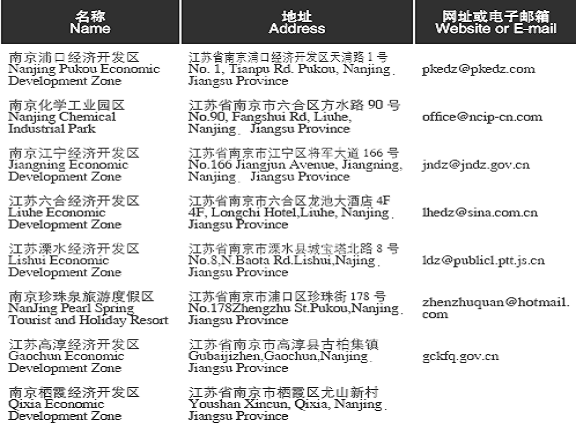
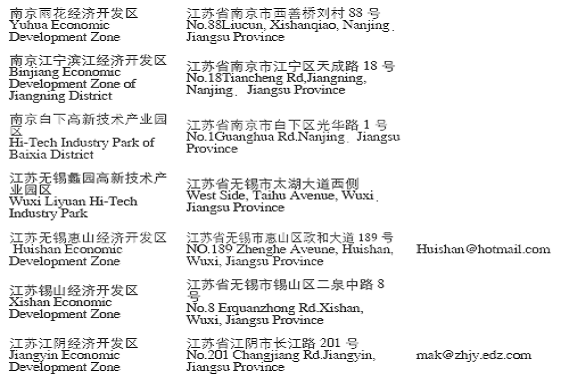
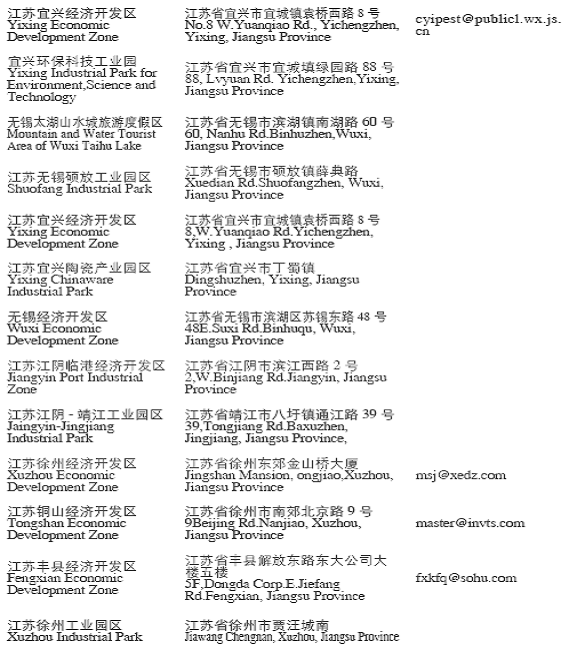
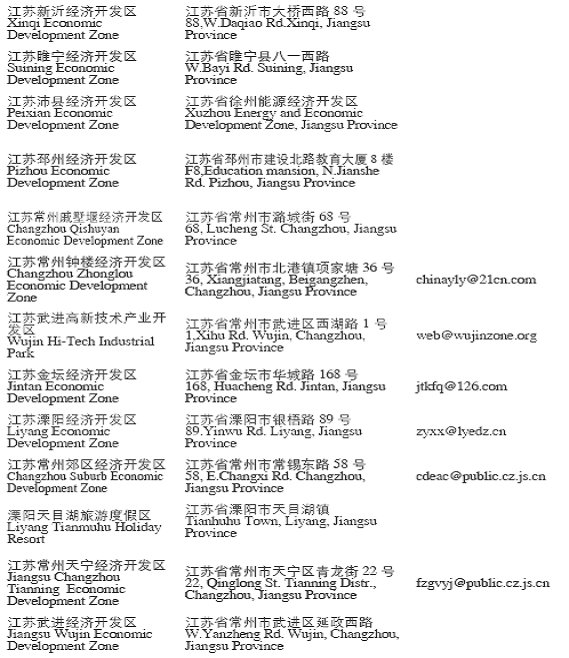
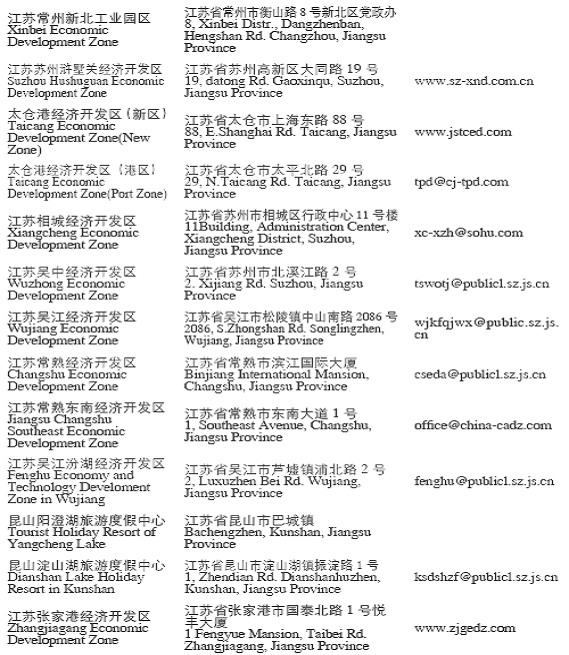


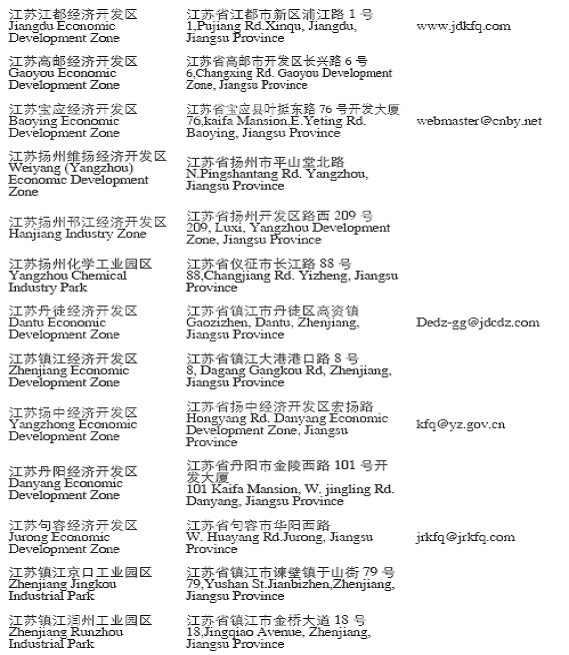
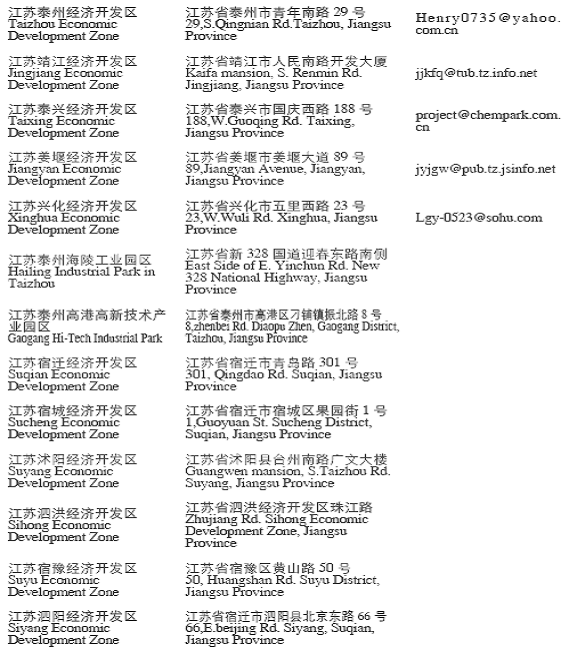
(ii) Related Departments

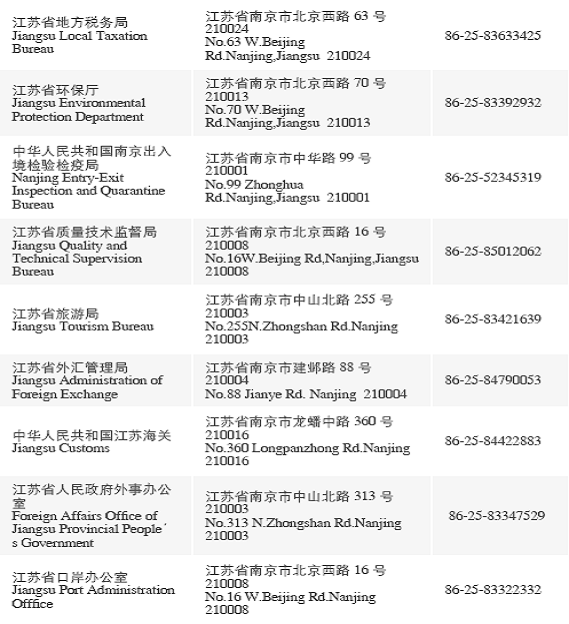
(iii) Related Website
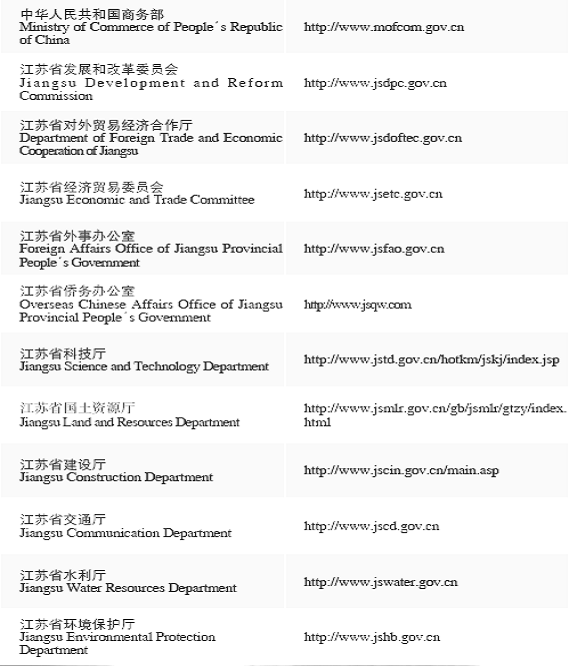
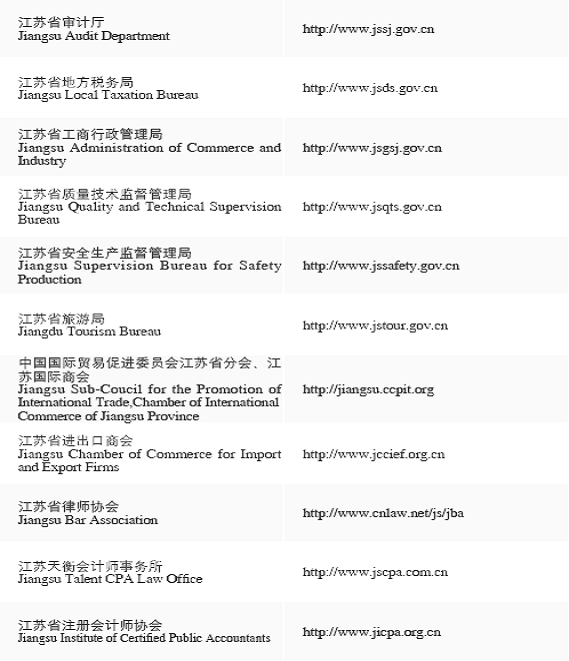
Appendix
1. Major Restaurants and Hotels in Jiangsu

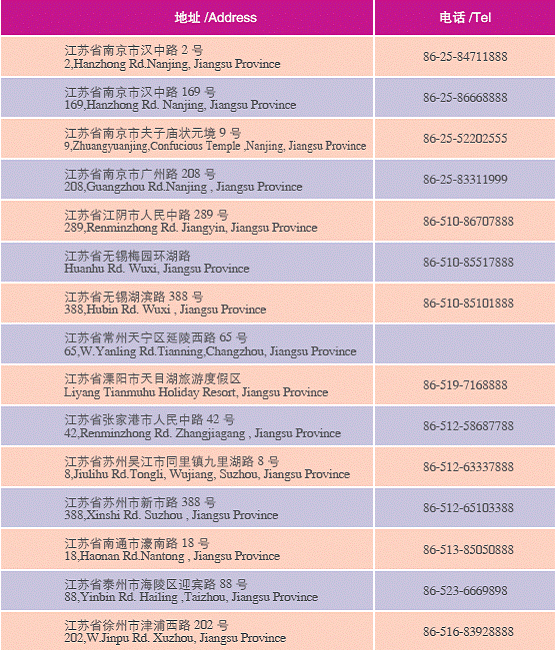
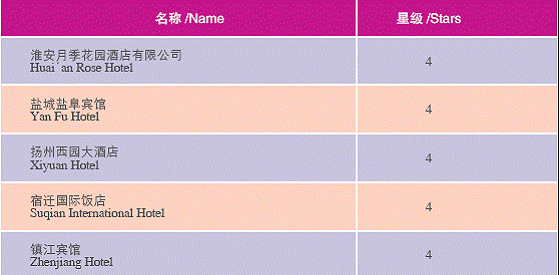
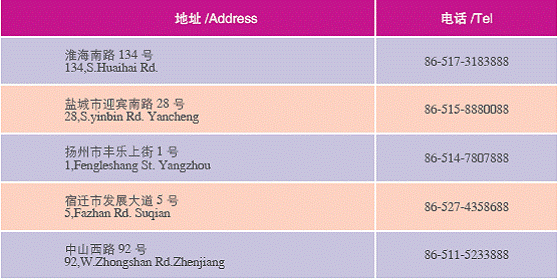
2. Telephone Numbers for Emergency and Information
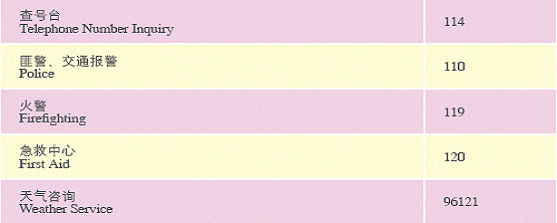
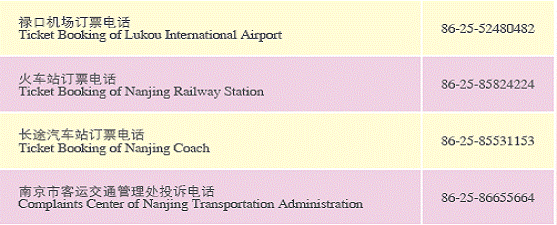
(Ministry of Commerce)